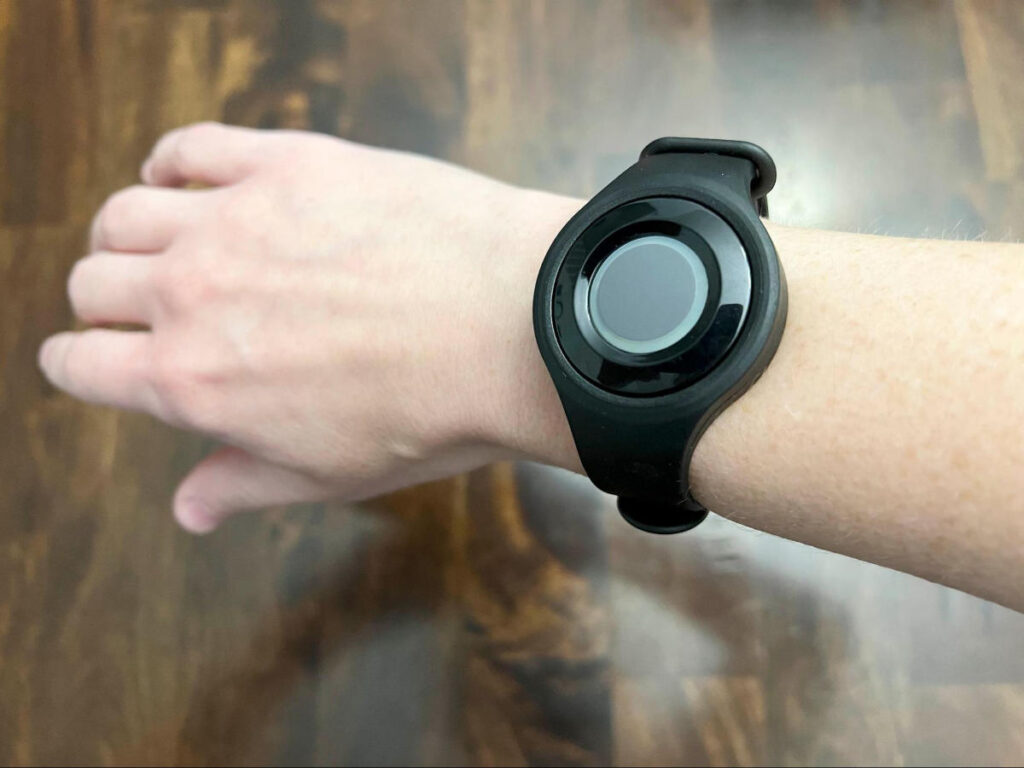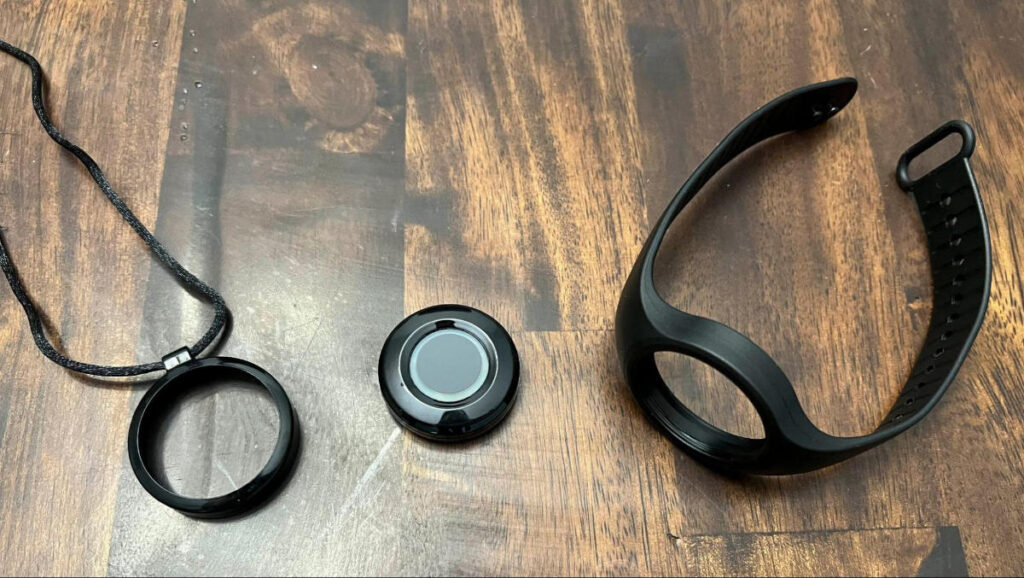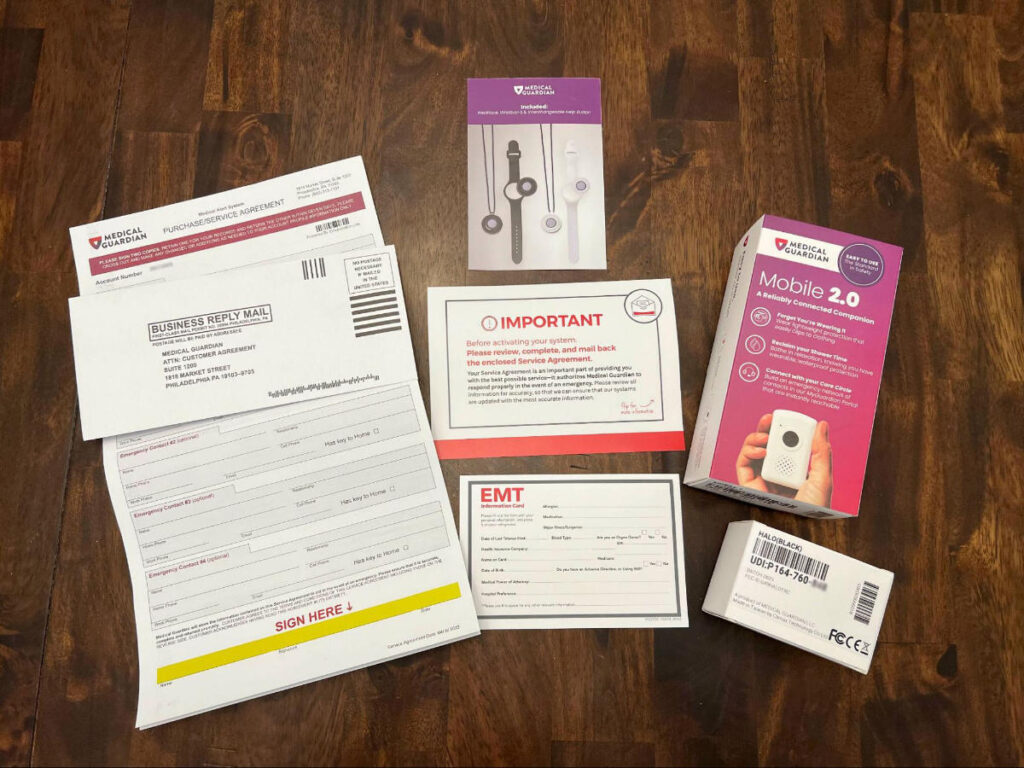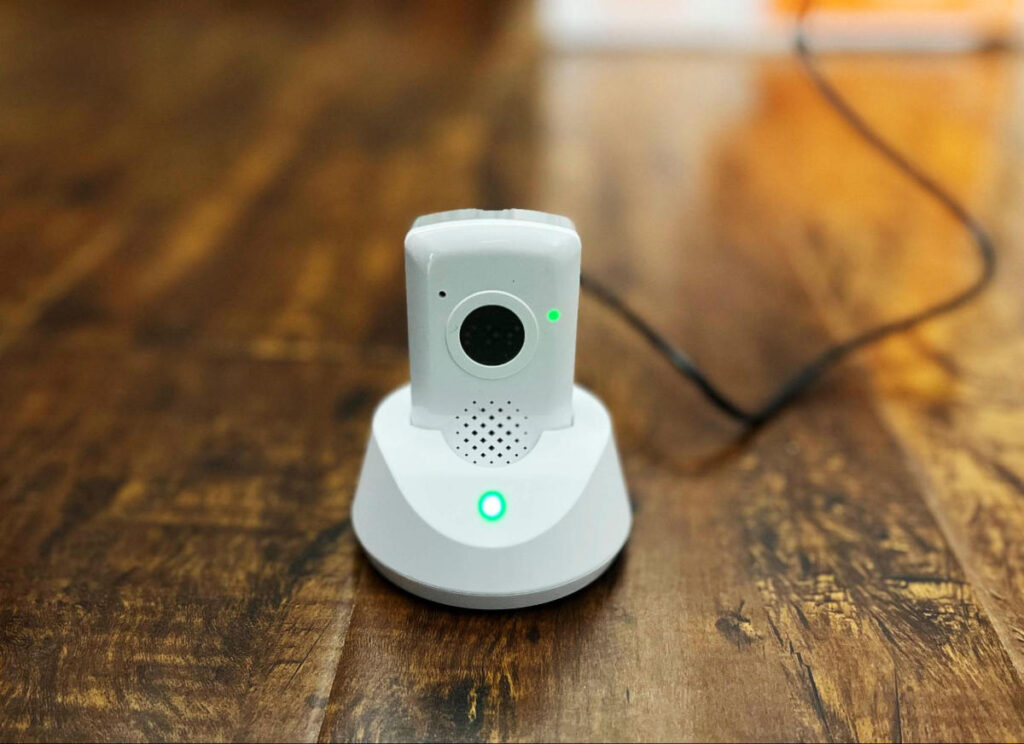MedicalAlertBuyersGuide.org is an independent review site. We may earn money when you click on links on our site. Learn More
Medical Guardian MGMini Review
Updated: March 2024| ReliaScore™ 8.5 / 10
Product Overview

The Medical Guardian MGMini Lite offers a mobile system with GPS tracking that can be configured in several different ways for portability.
Medical alert systems with GPS tracking capability help seniors feel more confident and stay independent. They also help families and friends keep an eye on vulnerable loved ones who may be high-risk from physical conditions or memory problems. Staying active also wards off dementia.
While the MGMini system technically can be used by up to two people, in practice it works best protecting one person, similar to other mobile systems. The MGMini comes with an online portal that will accommodate multiple caregivers.
Medical Guardian is a well-established and growing company with a broad suite of offerings to choose from. In this article, we tested the GPS device without fall detection.
Key Features
The MGMini consists of a charging cradle, a base device with alarm button and 2-way voice contact, and a clip-on attachment for belt or purse, etc. There’s a companion wearable alarm button that fits into either a pendant necklace or wristwatch band that are both included. There is no speaker or microphone built into the button.

Both have good battery life:
- The pendant and wristwatch alarm button doesn’t need charging and has a 3-4 year battery life.
- The base device will hold its charge for 3-5 days.
The pendant/wristwatch are water-resistant for 30 minutes (IP67 rated), so you can wear them in the shower. On an alarm, operators will talk through the base device. For our experience, the separate alarm button came already paired with the base device.
The wearable works up to 1,400 feet away from the base device. Two people can be enrolled on one MGMini plan by ordering a second wearable pendant/wristwatch alarm button. Medical Guardian offers free monitoring for the second wearable. However, this is only feasible if both people are always together. The customer service representative also mentioned that each person would need to be within 500 feet of the base device for reliability.
Here are a few other facts about the MG Move 2.0.
- The system works on the AT&T 4G LTE cellular network.
- It has built-in GPS for location tracking.
Medical Guardian claims to have the fastest response time. Operators are 911-trained and certified, and they are all based in the USA. During an emergency, operators use the GPS location rather than the address in the user account, which might not be accurate at the time. They dispatch an ambulance if required and contact up to 4 people on the user call list.
Our Ordering Experience
Website Review
Prior to purchase, we visited the Medical Guardian website and studied their product offerings for mobile alert systems. We could compare the differences between products shown in a clear and easy-to-read table, although there were no dimensions given for each product, nor prices, which was frustrating. From this comparison table, we had to select one product and choose to Buy Now in order to discover pricing and monitoring options.
During the entire process, we didn’t find any hidden or extra fees.
Since the restocking fee to return the product is vague in the policies page, we had to call to determine the exact fee structure. Read our Pricing section below to learn more about their confusing fees.
Sales & Services Contacts
We had substantial contact with sales and customer service reps and found their service friendly and prompt. After we were somewhat confused by the website experience, the sales rep we spoke to gave us clear and helpful guidance on which system and plan to go with for our situation. When we explained that we had difficulty getting our senior to wear an alert device, she completely understood.
The telephone customer care is closed on Sundays, which could present problems if that is one of the only days and times one can help family members with any issues or confusions the wearer might have.
Ordering
We ordered the MGMini system by choosing a monitoring subscription plan. The equipment is an additional charge, which we didn’t discover until AFTER we added the monitoring to our shopping cart.
As we completed the purchase online, the checkout process was relatively easy to follow, except that the Submit Order button would not appear. It was not just grayed-out but missing completely. Initially, we thought it might be a browser compatibility issue until we realized we needed to type in our credit card number and select the type of card. This added to our frustration, since online ordering is supposed to be easy and convenient.
The checkout does allow contact information for two different people, so that the person paying the billing can be separate from the actual device user.
During the transaction, there was no option to set up an account for future purchases like you usually see in online retail systems. Also, there are no questions about medical history or medications during the purchasing process.
Following checkout, the system asks the purchaser to sign an authorization allowing Medical Guardian to properly respond to alerts. This was via DocuSign, but it presented an error message during the process so we couldn’t sign it immediately. We did not attempt to resolve this issue, nor did Medical Guardian address it when we set up the product. If you do purchase MG Mobile, we recommend that you confirm the DocuSign with the customer service team.
After completing the purchase, we received an immediate confirmation email. We ordered on a Wednesday, and the system arrived on Sunday — for a 4-day delivery time. The product arrived as ordered, with no extras.
Too Much Follow-up
After speaking with the customer service representative to ask initial questions, we got a call and voicemail from Medical Guardian six times in 12 days with the rep trying to close the sale and sell us a product. Some people might like the calls as a reminder, but we found it a touch aggressive and irritating. The calls stopped after we answered one and said we were not interested. While we provided a phone number in our initial call, we thought it was in case we got disconnected.
Additionally, because of the website trouble we experienced when ordering, we received a call from a different customer service rep asking if we had trouble ordering on the website. We also got a follow-up email from that second rep. Our tester felt a little creeped out by this, since users don’t create accounts while ordering, so it was not obvious Medical Guardian was storing data that was entered before completing the transaction.
Our Testing Experience
Unboxing and Setting Up

The device arrived well padded, although this might cause difficulty for someone with limited dexterity to unpack. But in less than a minute after plugging the base device into power, the device spoke with a “Device ready” prompt.
However, the device flashed a red light indicating less than 20% battery life as soon as we took it off the charger. Pressing the small “Smart Voice Assist” button on the side returned the voice message: “Cellular signal good. Battery level very low. Charge your device immediately.” After hearing the “device ready” prompt, this was confusing. But placing the device on the charger returned a reassuring “Charging” voice response.

In setup, we tried to pair the pendant with the system (this was not clear), and we had to call customer service for help. We discovered that the pendant was already paired.
Our package included the charging cradle, base clip-on device, the pendant and a wristband alternative. An interchangeable help button snaps into either the pendant or the wristband, for a choice of necklace or wristwatch style of wearing.
In all, it took about 25 minutes to unbox, activate and complete the setup of the system.
Activation
The device prompts the user to call through the device to activate the system. Customer service again was very helpful and friendly. We set up an emergency contact but were not asked for medical history. While we waited for the system to complete, the rep highlighted the device’s technical features for us.
The service rep had us press the pendant button to activate the alarm. During this test we spoke to the base system for a voice and name recording, which the device repeated back to confirm. The rep confirmed that the system was working perfectly, and we were done – in about six minutes. By then, we knew the pendant was already paired so all components were ready.
Since the device came with a low battery, we had to wait a few hours for the device to charge until we could begin testing. The documentation says a full charge takes four hours.
Testing – Call Center and Response Experience
NOTE: This review doesn’t cover fall detection.
Our interactions with the Medical Guardian monitoring service were positive. We timed the responses to emergency alerts and were contacted by a live operator in 24 seconds, and again on another day in 30 seconds.
The pendant claims a maximum range of 1,400 feet away from the base device to work. We tested it at 300 feet in line of sight and it worked. In-home safety is a significant concern for many families. In fact a 2020 report by the US Census Bureau noted that only 10% of homes are “aging ready” and safe for seniors. Note that you can activate the alert button to call for help when it is 300 feet from the base device, but you will not be able to talk to the operator.
The wearable wristband is slightly larger than a smartwatch or wristwatch, and may seem too bulky for someone with a slender frame. The black wristband is discreet, and the gray button color is neutral. The pendant necklace is not designed for attractiveness but the adjustable string allows for variable adjustment without any excess hanging out, so the length can be adjusted for the outfit worn.
The battery doesn’t appear to be removable from the help button, but battery life is claimed to be 3—4 years. The base battery is rechargeable and holds a charge for 3—5 days. It’s not clear to us what the procedure is to replace worn-out batteries.
There is no medication reminder built into the MGMini.
The system is not UL certified, but is CE certified. UL certification is more common in the U.S., while CE certification is required for certain medical devices in Europe. The CE quality certification means the device complies with all essential health and safety laws and regulations in the EU.
The emergency system allows Medical Guardian to call emergency contacts if the emergency button is pressed. However, we couldn’t test this because it would require a real emergency.
Online Portal
The MyGuardian online portal allows the user or a caregiver to view the status of the device in terms of battery level, connection strength, and technical details. It shows at a glance the recent alarm history, and the current location of the device on Google Maps. This location updates in real time as you refresh the view, so you can track the approximate movements of the wearer.
The location shown for the wearable pendant in the tracking portal is at least 100 feet away from its exact location. It’s unclear if this might cause any confusion for emergency responders homing in on these tracking coordinates.
In the portal you can see account details and billing information, contact Support, and manage more than one caregiver. The dashboard is clearly laid out with big buttons for menu choices. This matches the standard features of most caregiver portals.
Medical Guardian’s system pings the base device every hour to test for connection. You can see this logged in the portal history.
Pricing
The MGMIni operates on the subscription plan for the monitoring, with an additional cost to buy the hardware itself. Note that the hardware cost for the device was not obvious until after we added a subscription to the shopping cart. Obviously, this is another thing that could be clarified up front in the website language.
Subscription costs depend on the payment plan:
- Pay Monthly: $44.95/mo
- Pay Quarterly: $44.95/mo
- Pay Yearly: $41.20/mo
Hardware Cost:
- $149.95 (+$12.50 shipping)
There are no contracts, and the service can be canceled at will. However, see below for details on returns and fees.
The table below shows how the MGMobile Lite compares to other mobile medical alert systems. With its higher Startup Cost and high Monthly Monitoring Cost, the system is one of the more expensive options on the market, with only Lifeline On The Go having a higher first year cost of ownership.
Price Comparison, First Year Cost of Ownership
| Company | System | Startup Cost | Monitoring | Fall Detection | First Year Total Cost |
|---|---|---|---|---|---|
| Lifeline | On The Go | $129.90 | $49.95/month | $15.00/month | $909.30 |
| Medical Guardian | MGMini Lite | $162.45 | $44.95/month | $10.00/month | $821.85 |
| MedicalAlert.com | Mobile | $124.90 | $47.95/month | $10.00/month | $820.30 |
| Bay Alarm Medical | SOS Mobile | $69.30 | $34.95/month | $10.00/month | $620.70 |
| MobileHelp | Mirco | $0 | $39.95/month | $11.00/month | $611.40 |
| Lively | Mobile+ | $49.99 | $24.99/month | $9.99/month | $469.75 |
2 - First Year Total Cost assumes a monthly subscription plan with fall detection.
The company offers a $25 reward for each person you refer.
However, there are no discounts for AARP members. The company does offer coupons over the phone, but these only seem to be available as incentives during the sign-up process and may not exist as tangible discounts in their own right.
What’s included?
The hardware consists of a charging cradle, the base device with a belt clip, and the separate help button with wristband and necklace to insert it into. The pendant and wristband come in a choice of black or white. As previously mentioned, a second help button that pairs with the base device can be purchased separately.
What’s available?
The following were suggested as add-ons on the website, but it’s unclear if most of them apply to the MGMini Guardian:
Fall detection is available in a separate pendant for an extra $10 per month. However it does not come as a wristband feature, due to false alarm propensity.
A wireless wall button is available ($2.99/mo), and a voice-activated one also ($4.99/mo).
For $2.99/mo you can keep your contacts updated in real time to the wearer’s status.
A protection plan is available for $6.99/mo that offers overnight replacement for the hardware components (which on their own could cost $149.95 for the help button, for example).
A lockbox for emergency responders to enter the home is available for free.
Contracts
There is no minimum contract plan with the Medical Guardian subscription. However, see below for more details on the costs of returning the hardware to learn what actually makes most sense.
Returns
You can return the hardware for full money back within 14 days — if the product is unopened. If you’ve opened the package or are beyond 14 days, you must pay a restocking fee.
If you select the monthly plan and return the product after 14 days, you have to pay for 3 months of subscription. If you select quarterly and return the product timely, two months are refunded.
In effect, this means that there is a strong incentive to purchase the quarterly plan, and indeed this was the only point on which the sales rep was a little insistent. This advantage in choosing the quarterly pricing policy doesn’t seem to be very well explained up front.
We returned the hardware and talked to customer service to do this. We were offered several alternatives, which we declined, and the return process went smoothly from there. The restocking fee was a little over $50. We received our refund online, seven days after Medical Guardian received the returned equipment in their incoming delivery system.
Summary
| Pros: | Cons: |
|
|

 1-800-695-7419
1-800-695-7419